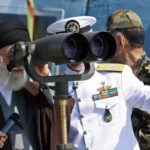The road not taken: Can Fukushima put us on a path toward nuclear transparency?
By Kennette Benedict | March 26, 2011
The disaster at the Fukushima Daiichi Nuclear Power Station is a sobering reminder that nuclear power relies on the most dangerous technology on Earth. Though we do not yet know what the total effects of this nuclear tragedy will be, we do know that plant workers are suffering from radiation exposure, that lowered water levels have partially exposed fuel rods causing irremediable damage, and that the release of radioactive materials has displaced thousands of residents and contaminated tap water and some food supplies.
Despite victories like the creation of the Atomic Energy Commission, and later the Nuclear Regular Commission, the secrecy that began with the Manhattan Project has tended to permeate the civilian nuclear program, as well as the military and defense programs.
Civilian energy from nuclear fission was a bright prospect in 1942, when Enrico Fermi controlled a chain reaction at the graphite pile under Stagg Field at the University of Chicago. At the time, most physicists understood that the release of nuclear energy could be used for a bomb, and the vision of a new energy source for electrical power and industrial development appealed to many.
But the bomb was created first. In an all-out war with Hitler’s Germany, the United States mobilized scientific talent, industrial acumen, and financial resources to make the first atomic bombs that dropped on Hiroshima and Nagasaki in 1945. From those origins in secret — and in haste — the technologies of nuclear energy were born.
Even as the armistice was signed with Japan, scientists and engineers worried that the US government was drawing a veil of secrecy around nuclear technology that would prevent the public from understanding the dangers of nuclear fission whether in weaponry or in civilian reactors. After World War II, the first atomic scientists advocated for openness in the development of nuclear science and technology. In 1946, they succeeded in placing the development of nuclear weapons under civilian, rather than military, control in government laboratories — and the Atomic Energy Commission (AEC) was born.
But fear and competition between the Soviet Union and the United States fueled the Cold War, leading to even greater secrecy about nuclear weapons development, with long-lasting consequences for public knowledge and policy debate about all things nuclear. The race to nuclear weapons development — without clear understanding and public accountability — was destructive to human health, to the reputation of the nuclear industry, and eventually, to the public’s trust in technological expertise and government regulation. Unfortunately, the end of the Cold War did not bring an end to the secrecy.
There will be many questions to ask in the weeks and months after the March 11 catastrophe. Some will focus on the events at the power station. Did the reactors withstand the 9.0 earthquake? Was loss of electrical power in the wake of the tsunami the real culprit in this cascade of catastrophes? Could any nuclear power company have prepared for an event of this magnitude?
In the meantime, however, several broader questions need to be asked to provoke a deeper public discussion than has ever taken place about civilian nuclear power. First, are there nuclear reactor designs that would pose less risk to communities than those in use now? Some concepts of the 1950s, such as the traveling wave or pebble bed designs, were shelved in favor of designs that cost less to build and served two purposes generating heat for electricity generation and producing plutonium for nuclear weapons. Safety may have taken a backseat to the need for nuclear weapons to fight the Cold War.
Second, why do nuclear technology and plant operations continue to be relatively closed to public view? Despite victories like the creation of the AEC, and later the Nuclear Regulatory Commission (NRC), the secrecy that began with the Manhattan Project has tended to permeate the civilian nuclear program, as well as the military and defense programs. As corporate business took over the civilian side of nuclear energy, proprietary interests replaced military security as the rationale for a continuing policy of opacity. In the 1970s, recognition of the conflict between the two missions of the AEC to promote the civilian program, on the one hand, and to inspect and monitor, on the other, led to the creation of the NRC that established stricter oversight rules and procedures. At that point, however, the underlying framework, early choices, and habits of thought made it nearly impossible to challenge the basic directions of nuclear energy development.
Third, how should governments dispose of radioactive spent fuel? In the 1950s, a bargain was struck in the United States between government and industry: Private companies would develop nuclear power if the government would take responsibility for nuclear waste left from burning enriched uranium. However, governments have been slow to dispose of the waste, which has led, in turn, to overstocking spent fuel pools at nearly all power stations in the world. One result: increased dangers from these stocks, and in the case of Fukushima, potential toxic emissions of cesium 137 and strontium 90 in the event that exposed spent fuel rods heat up.
The origins of civilian nuclear power in the nuclear weapons program of World War II and in the context of military and economic competition between the United States and the Soviet Union set our societies, and the nuclear industry, on a path. That path led to technical designs and decisions that were less focused on community safety and long-term health consequences than on cost-savings and military needs — and less concerned with public accountability than with protecting technical secrets.
Can we choose another path? Will governments and industry invest in radically different and safer reactor designs, in open processes of decision-making and accountability, and in transforming nuclear energy dramatically to reduce the risks to health and community? Can we take the time now to get this most dangerous technology right, and to protect future generations from the deadly consequences of future nuclear disasters?
Together, we make the world safer.
The Bulletin elevates expert voices above the noise. But as an independent nonprofit organization, our operations depend on the support of readers like you. Help us continue to deliver quality journalism that holds leaders accountable. Your support of our work at any level is important. In return, we promise our coverage will be understandable, influential, vigilant, solution-oriented, and fair-minded. Together we can make a difference.
Topics: Columnists, Nuclear Energy














